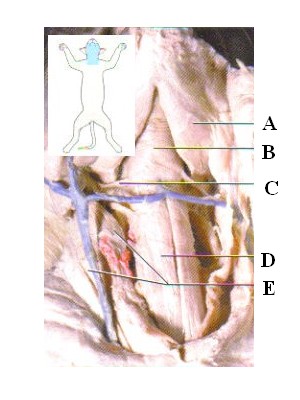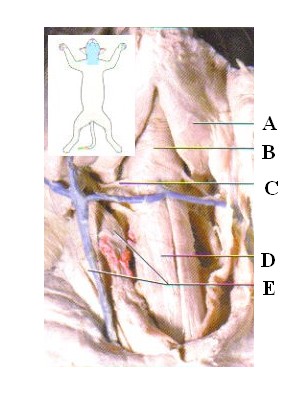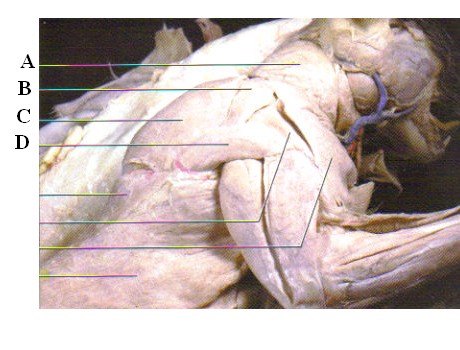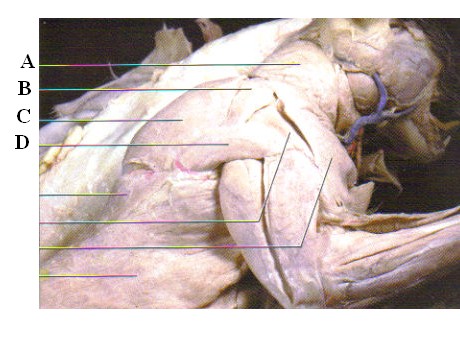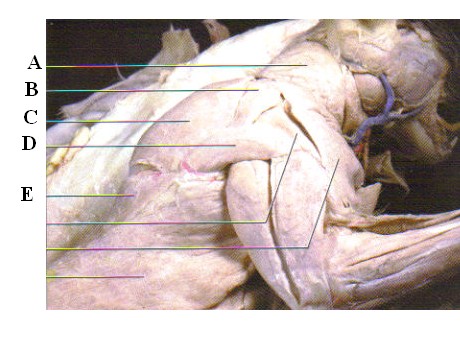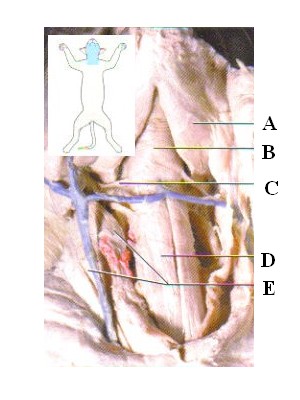Branchiomeric Muscles Of A Cat
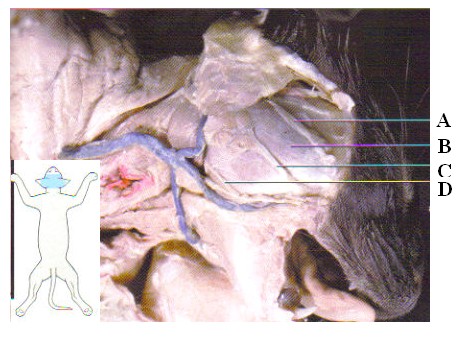
This quiz is designed to help students recognize the branchiomeric muscles of a cat. It will also help them learn the origins, insertions, and actions of these muscles.
- 1.
ID the muscle labeled "B" in the picture.
- A.
Temporalis
- B.
Digastric
- C.
Masseter
- D.
Pterygoideus Externus
Correct Answer
C. MasseterExplanation
The correct answer is Masseter. The muscle labeled "B" in the picture is the masseter muscle. The masseter is a powerful muscle located in the jaw region. It is responsible for closing the jaw and is one of the main muscles involved in chewing.Rate this question:
-
- 2.
The masseter muscle is responsible for elevation of the ____________ . (specific bone)
Correct Answer
mandibleExplanation
The masseter muscle is responsible for elevating the mandible. The mandible is the specific bone in the skull that forms the lower jaw. When the masseter muscle contracts, it causes the mandible to move upwards, allowing for actions such as biting and chewing.Rate this question:
- 3.
True or false: The masseter and the temporalis both work toward the same action.
- A.
True
- B.
False
Correct Answer
A. TrueExplanation
true- they both work toward elevating the mandibleRate this question:
-
- 4.
ID the muscle labeled "B" and give its action.
- A.
Mylohyoid; protracts the hyoid
- B.
Mylohyoid; elevates the floor of the mouth
- C.
Digastric; retracts the hyoid
- D.
Digastric; elevates the floor of the mouth
Correct Answer
B. Mylohyoid; elevates the floor of the mouthExplanation
The correct answer is Mylohyoid; elevates the floor of the mouth. The mylohyoid muscle is responsible for elevating the floor of the mouth, which helps in actions such as swallowing and speaking. It forms the floor of the oral cavity and supports the tongue.Rate this question:
-
- 5.
The muscle labeled "A" is the ________ muscle.
Correct Answer
digastricExplanation
The muscle labeled "A" is the digastric muscle. The digastric muscle is a paired muscle located in the neck and is named for its two bellies. It is responsible for opening the mouth and depressing the mandible, as well as elevating the hyoid bone during swallowing and speaking.Rate this question:
- 6.
The digastric muscle _________ the mandible.
- A.
Protracts
- B.
Retracts
- C.
Elevates
- D.
Depresses
Correct Answer
D. DepressesExplanation
The digastric muscle is responsible for depressing the mandible. This means that it helps to lower the jaw bone.Rate this question:
-
- 7.
Choose the correct function of the muscle labeled "C"
- A.
Pulls the scapula dorsally and caudally
- B.
Flexes the forearm
- C.
Adduct and stabilize the position of the scapulae
- D.
Pulls forelimb dorsocaudally
Correct Answer
C. Adduct and stabilize the position of the scapulaeExplanation
The correct function of the muscle labeled "C" is to adduct and stabilize the position of the scapulae. This means that it pulls the scapulae towards the midline of the body and helps to keep them in a stable position. This muscle does not flex the forearm or pull the forelimb dorsocaudally, as stated in the other options.Rate this question:
-
- 8.
The clavotrapezius, labeled "A" in the picture above, protracts the __________ .(specific bone)
Correct Answer
humerusExplanation
The clavotrapezius muscle, labeled "A" in the picture, is responsible for protracting the humerus bone. Protraction refers to moving the bone forward or bringing it closer to the midline of the body. Therefore, the clavotrapezius muscle plays a role in moving the humerus bone forward.Rate this question:
- 9.
This muscle is the most posterior of the trapezius group:
Correct Answer
spinotrapeziusExplanation
The spinotrapezius muscle is the most posterior muscle in the trapezius group. The trapezius group consists of three muscles: the spinotrapezius, acromiotrapezius, and clavotrapezius. The spinotrapezius muscle is located at the posterior aspect of the trapezius group, making it the furthest back. It originates from the spinous processes of the thoracic vertebrae and inserts onto the spine of the scapula. Its main function is to retract and stabilize the scapula.Rate this question:
- 10.
The muscle labeled "E" in the picture above is responsible for this action:
- A.
Pulling the scapula dorsally and caudally
- B.
Pulling the forelimb dorsocaudally
- C.
Flexing the forearm
- D.
Pulling the ribs in cranially
Correct Answer
A. Pulling the scapula dorsally and caudallyExplanation
The muscle labeled "E" in the picture is responsible for pulling the scapula dorsally and caudally. This means that the muscle is involved in moving the scapula in a direction towards the back and tail. It does not have any role in pulling the forelimb dorsocaudally, flexing the forearm, or pulling the ribs in cranially.Rate this question:
-
- 11.
The ___________ muscle, which is responsible for turning the head while the clavicle is stationary, is located dorsolateral to the sternomastoid.
Correct Answer
cleidomastoidExplanation
The cleidomastoid muscle is responsible for turning the head while the clavicle is stationary. It is located dorsolateral to the sternomastoid muscle.Rate this question:
- 12.
The insertion of the cleidomastoid is the:
- A.
Hyoid bone
- B.
Thyroid cartilage of the larynx
- C.
Mastoid process of the temporal bone
- D.
Dorsal border of the scapula
Correct Answer
C. Mastoid process of the temporal boneExplanation
The insertion of the cleidomastoid muscle is the mastoid process of the temporal bone. The cleidomastoid muscle originates from the clavicle and inserts into the mastoid process. This muscle is responsible for various movements of the head and neck, including rotation and lateral flexion. The mastoid process is a bony prominence located behind the ear, and it provides a strong attachment point for the cleidomastoid muscle.Rate this question:
-
- 13.
ID the muscle labeled "E" in the picture above.
- A.
Cleidomastoid
- B.
Sternomastoid
- C.
Digastric
- D.
Sternohyoid
Correct Answer
B. SternomastoidExplanation
The muscle labeled "E" in the picture is the sternomastoid muscle. This muscle is located in the neck and runs from the sternum and clavicle to the mastoid process of the skull. It is responsible for various movements of the head and neck, including rotation and flexion. The sternomastoid muscle is easily identifiable due to its prominent location and shape.Rate this question:
-
Quiz Review Timeline +
Our quizzes are rigorously reviewed, monitored and continuously updated by our expert board to maintain accuracy, relevance, and timeliness.
-
Current Version
-
Mar 21, 2023Quiz Edited by
ProProfs Editorial Team -
Apr 24, 2009Quiz Created by
Companatomy
- Aura Quizzes
- Axial Skeleton Quizzes
- Body Mechanics Quizzes
- Body Parts Quizzes
- Body System Quizzes
- Chest Quizzes
- Ear Quizzes
- Endocrine Quizzes
- Eye Quizzes
- Feet Quizzes
- Gland Quizzes
- Limb Quizzes
- Musculoskeletal Quizzes
- Pain Quizzes
- Pharmacodynamics Quizzes
- Piercing Quizzes
- Spanish Body Parts Quizzes
- Thorax Quizzes
- Urine Quizzes
 Back to top
Back to top



